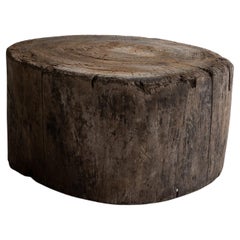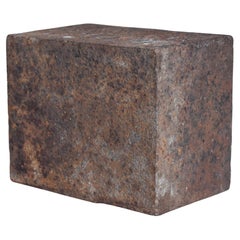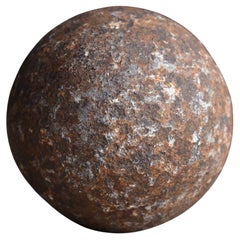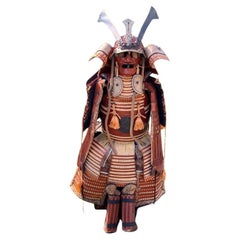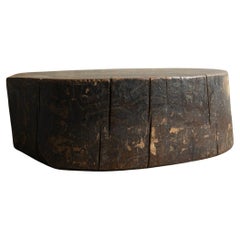Japanese Antiquities
to
82
131
41
381
13
2
3
2
1
29
118
234
15
111
26
60
4
2
4
2
1
3
5
5
15
2
178
101
75
48
47
1,901
1,343
739
396
388
396
393
393
10
1
1
Place of Origin: Japanese
Japanese antique wooden work board / Wabi sabi / Display stand / Side table
Located in Sammu-shi, Chiba
This is an old Japanese workbench made from zelkova wood (keyaki),
known for its strength and beautifully distinct grain.
The thick cross-section c...
Category
20th Century Taisho Japanese Antiquities
Materials
Wood
Japanese Old Iron Block 1950s-1970s / Display stand Wabi Sabi
Located in Chōsei District Nagara, JP
This is an old Japanese iron block, estimated to have been made in the early Showa period (1950s–1970s). At the time, it was used in ironworks as an anvil or workbench. Decades of us...
Category
Late 20th Century Showa Japanese Antiquities
Materials
Iron
Japanese Antique Artillery Shell 1900s-1920s / Iron Ball Object Wabisabi
Located in Chōsei District Nagara, JP
This is an old Japanese artillery shell.
From its appearance, it is assumed that it is an iron shell for artillery.
Considering the size, shape, and rusty condition of this iron ball...
Category
1910s Showa Vintage Japanese Antiquities
Materials
Iron
Japanese Red Samurai Armour Beginning of Meiji period 1900s
Located in Paris, FR
This is an armour of samurai. It was made around 1900s in Meiji era. This armour was not used in actual war so it was made as decoration, because of that, it is in good condition as its age.
There are some scratches and missing parts, if you need some more information, please let us know, we will respond you as soon as possible and send more photos.
This armour can be folded in a box. The box is getting damaged so it is not in good condition. We might send this armour in other box.
Dimensions: 50 x 50 x H170 cm
Scholars agree that Japanese armour first appeared in the 4th century, with the discovery of the cuirass and basic helmets in graves. During the Heian period, the unique Japanese samurai...
Category
Early 1900s Meiji Antique Japanese Antiquities
Materials
Metal, Iron
Japanese Old Rusted Toy Car "Porsche" 1960s-1980s / Figurine Wabisabi
Located in Chōsei District Nagara, JP
This is an old Japanese toy car, heavily rusted with age. Its form appears to resemble that of a Porsche, and it is believed to have been manufactured in the post‑war Showa period (1...
Category
Late 20th Century Showa Japanese Antiquities
Materials
Tin
Japanese antique wooden work board / 20th century / small display stand
Located in Sammu-shi, Chiba
This is an old Japanese wooden workbench made from zelkova wood (keyaki), known for its hardness and beautiful grain. The thick cross-sectional shape clearly reveals the concentric g...
Category
20th Century Taisho Japanese Antiquities
Materials
Wood
Japanese Antique Huge Wooden Bowl 1906s / Primitive Object Wabisabi Mingei
Located in Chōsei District Nagara, JP
This is a huge old Japanese lacquer wood bowl.
It was manufactured in 1906 (Meiji period), and its age can be read from the writing on the bottom. The material used is cedar wood, ma...
Category
Early 1900s Meiji Antique Japanese Antiquities
Materials
Cedar, Lacquer
Antique Japanese Kimono 'Uchikake' for Wedding, 1970s
Located in Paris, FR
This is a kimono called Uchikake which Japanese women wear for wedding ceremony.
It is said that the women wear the white uchikake for the reason of 'they can dyed in any color' and...
Category
Late 20th Century Showa Japanese Antiquities
Materials
Silk
Japanese Silk Haori Jacket Shibori Red 1980s Showa
Located in Paris, FR
This is a silk jacket which was made in Japan.
It was made in Showa era around 1980s.
The haori is a traditional Japanese hip- or thigh-length jacket worn over a kimono. Resembling ...
Category
1980s Showa Vintage Japanese Antiquities
Materials
Silk
Japanese Antique Combat Helmet 'Kabuto' 1800s Edo Era
Located in Paris, FR
This is an antique combat helmet made around 1800s in Edo era in Japan.
Kabuto is a type of helmet first used by ancient Japanese warriors which, in later periods, became an important part of the traditional Japanese armour...
Category
Early 19th Century Antique Japanese Antiquities
Materials
Iron
Japanese Half Kimono Belt Hanhaba Obi Sky Blue with Rose 1980s
Located in Paris, FR
This is a Japanese beautiful Kimono belt called 'Han haba obi'.
Both side are with motifs but different motifs. It is a belt for kimono but you can use as a table runner or wall deco...
Category
1980s Showa Vintage Japanese Antiquities
Materials
Silk
$210 Sale Price
20% Off
Japanese old wood stand / Exhibition stand wabi-sabi / primitive wood stand /
Located in Sammu-shi, Chiba
This display stand is made by combining old wooden sleepers with a newly made tabletop.
The top of the display stand is finished with cashew paint, like lacquer, and has a jet blac...
Category
Mid-20th Century Primitive Japanese Antiquities
Materials
Wood
Old Japanese black maneki-neko object / 20th century / lucky ornament
Located in Sammu-shi, Chiba
Here is a Japanese "Maneki Neko" (beckoning cat) figurine from the Showa era. It is made from either clay or plaster and features a simple yet impactful design. On the back, you can ...
Category
20th Century Showa Japanese Antiquities
Materials
Plaster, Clay
Japanese Antique Thatching Tools "Gangi" 1860s-1920s / Wall Decoration Wabisabi
Located in Chōsei District Nagara, JP
This is a traditional Japanese thatched roof tool known as a “Gangi.”
A Gangi is used to trim the cut ends of the thatch and smooth the roof’s surface, symbolizing the craftsmanship ...
Category
Early 20th Century Meiji Japanese Antiquities
Materials
Cedar
Japanese antique pottery fragments/12th to 13th century/Flower vase
Located in Sammu-shi, Chiba
Tokoname ware is a historic kiln in Japan, where pottery has been made since before the Common Era, and a kiln was established in the 5th century. This kiln is located in Aichi Prefe...
Category
15th Century and Earlier Other Antique Japanese Antiquities
Materials
Pottery
Antique Korean Stone Pot / Joseon Dynasty / Stone Folk Art Object
Located in Sammu-shi, Chiba
This stone pot was made in Korea during the late Joseon dynasty, between the late 19th and early 20th centuries. Its sturdy appearance, carved from a granite-like stone, emanates a p...
Category
Late 19th Century Other Antique Japanese Antiquities
Materials
Stone
Japanese Antique Natural Wood Penis 1860s-1920s / Figurine Object Wabisabi
Located in Chōsei District Nagara, JP
This is a phallic statue made of natural wood produced in Japan.
It is estimated to have been created during the Meiji and Taisho periods (1860s-1920s), and is made of richly texture...
Category
Early 20th Century Meiji Japanese Antiquities
Materials
Pine
Japanese Antique Hyakumanben Buddhist Prayer Beads 1830s-1844s / Zen Wabisabi
Located in Chōsei District Nagara, JP
This is an antique Japanese Hyakumamben (Buddhist) prayer bead set.
A Hyakumamben is a large ceremonial rosary used in Buddhist prayer services, where many monks and worshippers form...
Category
1830s Edo Antique Japanese Antiquities
Materials
Straw, Wood
Antique Japanese Zushi, wabi sabi miniature shrine w/ Ebisu figurine mingei
Located in 常陸大宮市, JP
Antique wooden Zushi (miniature shrine, the "house of the Gods") with mini wooden figurine of Ebisu - from Tohoku area., Japan.
Manufactured circa 1860s - 1900s (late Edo to Meiji pe...
Category
Late 19th Century Primitive Antique Japanese Antiquities
Materials
Wood
Extremely Rare Tokugawa Clan Kimono Hanger with Maki-e Lacquer. Edo period
Located in Fukuoka, JP
Extremely Rare Tokugawa Clan Kimono Hanger with Makie Lacquer and Gilded Fittings
Edo Period, 18th–19th Century Dimensions: H 166 cm × L 187 cm × W 41.5 cm Materials: Wood, Lacquer...
Category
18th Century Edo Antique Japanese Antiquities
Materials
Metal
Japanese wooden wabi-sabi board/Early 20th century/Display stand/MINGEI
Located in Sammu-shi, Chiba
This is an old wooden work board called a “Kate-Kiri-Ban,” which was used in the Aizu region of Fukushima Prefecture, Japan, around the early 20th century. The name breaks down as fo...
Category
Early 20th Century Taisho Japanese Antiquities
Materials
Chestnut
Hirado Porcelain Koro Censer Meiji Dynasty
By Hirado
Located in Mérida, YU
This is an original Japanese Antique Porcelain Hirado Koro Censer circa 1850-1890 Meiji Dynasty.
In perfect condition.
Museum
Category
Late 19th Century Japonisme Antique Japanese Antiquities
Materials
Porcelain
Japanese Antique chestnut wood Cabinets, Wabi Sabi, Japandi
Located in Katori-Shi, 12
This is an antique glass cupboard from the Taisho era.
It is made of chestnut wood, and beautiful grain can be seen everywhere due to aging.
The pattern on the drawers subtly highl...
Category
Early 20th Century Taisho Japanese Antiquities
Materials
Wood
Antique Japanese Koto Wakizashi Sword
Located in Dallas, TX
Japanese Koto Wakizashi Sword
Japan
Ca. 1400-1600s
Length: 24.25” Blade
Total Length: 27.25
Nagasa: 18.5”
Koto wakizashi, with wild midare (Soshu?) hamon, including wild boshi. Hada indeterminate, with Shakudo & gold dragon menuki, beehive design fuchi kashira...
Category
16th Century Japonisme Antique Japanese Antiquities
Materials
Steel
Japanese Antique Wooden Board , Wall Decoration Abstract Art , Wabi-Sabi
Located in Katori-Shi, 12
This wooden board was made in the Taisho era.
The dense and beautiful grain of the wood, unique to time-honored zelkova, is eye-catching. The color that has deepened over the years,...
Category
Early 20th Century Taisho Japanese Antiquities
Materials
Wood
Japanese bronze Koro
Located in Beuzevillette, FR
Impressive handmade large and powerfully cast Japanese tripod bronze censer of the 19th century, made during the Meiji period and with mythical animals...
Category
19th Century Antique Japanese Antiquities
Materials
Brass
$3,104
Japanese Old Shell Casing 1930s-1940s / Iron Object Flower Vase Wabi Sabi
Located in Chōsei District Nagara, JP
This is the warhead part (shell) of an old Japanese shell. Functional parts such as the internal explosive and fuse have already been lost, and we present this as a safe relic that h...
Category
1930s Showa Vintage Japanese Antiquities
Materials
Iron
Fine Antique Japanese Cloisonne Ginbari Pigeon Blood Enamel Vase Big
By Ando Jubei
Located in San Diego, CA
Fine antique Japanese Cloisonne Ginbari pigeon blood enamel vase. High quality vase and made well. Dates from the mid part of the 1900's. Beautiful colorful chrysanthemum flowers and...
Category
Early 20th Century Japanese Antiquities
Materials
Enamel
$500 Sale Price
20% Off
Japanese Antique Exhibition Table / Wall Decoration / 1868-1912s / Wabi-sabi
Located in Iwate-gun Shizukuishi-cho, Iwate Prefecture
This is an old Japanese wooden work board.
The wood is cedar, and due to long-term use, the black color around the edges remains, and the color has peeled off only in the middle. Th...
Category
Late 19th Century Meiji Antique Japanese Antiquities
Materials
Wood, Cedar
Asian 19th Century Ningyo Doll
Located in Los Angeles, CA
Beautiful Asian 19th Century Ningyo doll. Great addition to your Asian inspired interiors and table tops.
Category
19th Century Other Antique Japanese Antiquities
Materials
Cotton
Japanese Antique flower stand, Wabi-Sabi, Japandi
Located in Katori-Shi, 12
It has a soft, rounded top and potter's wheel legs with a dignified appearance.
This flower stand was made in the Taisho period.
The lines that taper slightly towards the end of the ...
Category
Early 20th Century Taisho Japanese Antiquities
Materials
Wood
Japanese Antique Black Lantern Box /1896s Objet d'art Wabi-sabi
Located in Iwate-gun Shizukuishi-cho, Iwate Prefecture
This is a lantern box from the old days of Japan.
The box is pasted with Japanese paper and painted with black lacquer.
There is a description of "Meiji 29" on the back.
The lantern box is a box that stores folded lanterns...
Category
1890s Meiji Antique Japanese Antiquities
Materials
Wood, Cedar, Paper
$320 Sale Price
46% Off
Japanese antique wooden octagonal display stand/bonsai stand/flower stand
Located in Sammu-shi, Chiba
This is an old wooden flower stand from Japan.
It is believed to be from around the 20th century.
Originally, it may have been used in temples to hold offerings of flowers, but this ...
Category
20th Century Taisho Japanese Antiquities
Materials
Wood
Japanese Antique Pottery Manekineko Rocking Cat Object 1970s
Located in Paris, FR
This is a vintage piggy bank of manekineko cat. It is made with pottery and it was made around 1970s in Showa era. This cat is rocking object, it is rare than the other manekineko ca...
Category
1970s Showa Vintage Japanese Antiquities
Materials
Pottery
Japanese Lacquered Wood Bowls 19th Century Asian Antiques 中国古董
Located in London, GB
Fine Pair Japanese Lacquered Wood Bowls 19th Century Meiji
Beautiful and elegant example of Japanese lacquer ware with and gold gilt, Rice bowls ...
Category
19th Century Antique Japanese Antiquities
Materials
Wood, Lacquer
18th Century, Japanese Edo Period Lacquer & Chain Mail Suit of Samurai Armor
Located in Atlanta, GA
Japanese, Edo Period (1603-1868), likely late 18th century.
Step into the rich tapestry of Japanese history with this exquisite 18th-century Edo Period Lacquer & Chain Mail Suit of Armor, a masterpiece that seamlessly blends martial craftsmanship with artistic elegance. Crafted during a period of unparalleled cultural refinement, this armor is a testament to the meticulous skill and dedication of Japanese artisans.
The Gosuko armor, at the heart of this ensemble, embodies the traditional armor design of the Edo Period. Each meticulously lacquered plate, carefully adorned with ornate motifs, reflects not only the functional sophistication required for battle but also the aesthetic sensibilities intrinsic to Japanese art. The incorporation of chain mail adds a layer of flexibility and mobility, harmonizing the demands of protection with the fluidity required in combat.
A crowning glory to this armor is the Kabuto Helmet, an iconic symbol of samurai identity and resilience. Its design not only provides formidable protection but also serves as a canvas for artistic expression. The helmet's form, combined with lacquer embellishments and a crest, creates a striking visual statement, a representation of the wearer's identity and lineage.
To complete the ensemble, the armor comes with a brocade fabric, adding a touch of regality to this already magnificent piece. The interplay of textures and colors in the brocade further elevates the visual impact, turning the act of donning this armor into a ceremonial experience.
For the discerning collector, this piece is presented in a lacquer armor box, meticulously crafted to safeguard and showcase the historical significance of the armor. The accompanying wood armor display stand serves as a stage, allowing this masterpiece to command attention in any setting, whether it be a private collection, museum exhibit, or a distinguished living space.
Owning this 18th-century Japanese Edo Period Lacquer...
Category
18th Century Japonisme Antique Japanese Antiquities
Materials
Iron, Gold Leaf
$10,000 Sale Price
20% Off
Japanese Antique Stone Display Stand / Objet / Before 1868s / Wabi-Sabi Mingei
Located in Iwate-gun Shizukuishi-cho, Iwate Prefecture
This is an old stone stand in Japan.
I don't know the details if it was used as a stand for beating straw, but it seems to be before the end of the Edo period.
The round silhouette...
Category
Mid-19th Century Rustic Antique Japanese Antiquities
Materials
Stone
Samuraï armor
Located in Brussel, BE
Amazing and unique Samuraï armor.
Early XXth century.
Composed of an iron helmet mounted with large standing rivets and "Kuwagata" decoration (shoe shaped decoration) on the front. R...
Category
Early 20th Century Japonisme Japanese Antiquities
Materials
Iron
$29,847
Japanese Antique Glass Low Table, Wabi Sabi
Located in Katori-Shi, 12
This antique low table was made in the Taisho era.
The tabletop is made of a single piece of high-quality zelkova wood. The legs are lathe-turned.
It is unified with a ginkgo surfa...
Category
Early 20th Century Taisho Japanese Antiquities
Materials
Wood, Glass
Japanese Antique Wooden Brazier/Hibachi Brazier/1868-1912s Wabi-Sabi
Located in Iwate-gun Shizukuishi-cho, Iwate Prefecture
This is an old Japanese brazier.
It is made of zelkova wood and is thought to date back to the Meiji period.
It features the strong grain of zelkova...
Category
Late 19th Century Primitive Antique Japanese Antiquities
Materials
Copper
Japanese Antique Chests of Drawers 1860s-1900s /Tansu, Wabi-Sabi
Located in Katori-Shi, 12
This small drawer was produced in the Taisho period.
This chest is made of sturdy cedar with a lacquer finish, with a base panel made of lightweight paulownia wood and an iron handl...
Category
Early 20th Century Taisho Japanese Antiquities
Materials
Wood
Antique Ceremonial Dress and Sword Tansu, Sendai, Japan
Located in Point Richmond, CA
Antique ceremonial dress and sword tansu, Sendai, Japan
Guaranteed to be authentic as described.
Category
Early 20th Century Japanese Antiquities
Materials
Iron
Contemporary Japanese Chochin Floor Lamp Limited Edition #1 Zen Washi
By Ryosuke Harashima
Located in Shibuya-ku, Tokyo
Name: OBAKE A
Contemporary style Japanese Washi Japanese traditional paper shade floor lamp. Washi shade is famous as Isamu Noguchi Akari lightings.
Base is made of brass. Limited pattern painted model. Edition of 3+1AP
E26,27 light bulb.
Available to work with 100-250V.
Artist statement
In Japan, there is an animist belief that the soul dwells in old tools that have passed a long time and turns into spirits such as "Youkai" or "OBAKE." Its existence lurks in the darkness of everyday life, sometimes causing fear and sometimes entertaining.
This lantern is not an old tool, but it is made by the historic "Kojima Shoten", where the 10th generation are craftsmen in Kyoto. It's rare nowadays, and it's a style in which lanterns are made from bamboo bones to assembling papers and painting in one workshop and go. So, I decided to transform the polite crafted Japanese lanterns, which have been run through a traditional history, into a modern and pop style. It's not just OBAKE lurking in the darkness, but an existence who snuggles up to us as a more sophisticated being.
These one-eyed OBAKE have a meaningful look that originated in ancient Sanskrit culture. The red-eye "A [a]" is the facial expression that is the first pronunciation to make a sound in Sanskrit, which means "truth" and "spirit of inquiry" at the same time. The blue-eyed "UN [hu?]" expresses the pronunciation to close the sound, and at the same time means "wisdom" and "nirvana." There is also the idea that describing the beginning and end of the universe is represented by considering the "A" and "UN" as a pair. In Asia, it is a common sight to see a pair of guardian statues...
Category
2010s Edo Japanese Antiquities
Materials
Brass
D1 Japanese Antiques Board painting, sliding door, fittings, Peony & Bamboo
Located in Niiza, JP
Size: Depth *3cm Width *87cm Height *173cm 8kg
Estimated packing size: (Sandwich with 5-10mm plywood)
12 × 100 × 185cm 35kg
This is an old fittings of ita-e (wooden board painting...
Category
19th Century Antique Japanese Antiquities
Materials
Cedar
Japanese Arita Kraak type Dish, Mid-17th century, Edo Period
Located in seoul, KR
This piece was created in Japan presumably during the second half of the 17th century, with two archaic-style kanji characters, "酬酬" (shu shu), engraved on the bottom. A identical piece is housed in the National Museum of Warsaw.
Period : Edo Period, Japan
Date : 17th century
Provenance : Acquired in late 1990s from Hongkong
Reference : National Museum of Warsaw - Inventory Number SKAZsz 1230 MNW
(Type : Highly related)
* Japanese Edo Period Kraak
The Japanese 17th...
Category
17th Century Antique Japanese Antiquities
Materials
Ceramic
Japanese Antique Lacquer Hair Comb with Flowers in Gold Maki-e
Located in New York, NY
Stunning antique Japanese lacquer hair comb with a geometric petal-like background of stylized chrysanthemums and flowers done in gold and red maki-e. Possibly Edo or Meiji time peri...
Category
Mid-19th Century Antique Japanese Antiquities
Materials
Giltwood, Lacquer
Antique Japanese Bronze Koro (Incense Burner)
Located in Pomona, CA
Japanese bronze Koro (Incense Burner) in the form of two kids playing drum. This Koro was hand crafted in about early 20th Century with removable top. It has There is a Tai Chi Diagr...
Category
Early 20th Century Anglo-Japanese Japanese Antiquities
Materials
Bronze
$360 Sale Price
25% Off
18th Century Hirate Clan Samurai Armor with Signed Kabuto Helmet
Located in Fukuoka, JP
This is a truly exceptional set of 18th century Samurai armor that is sure to impress any collector or enthusiast. The patinated iron used in its construction has aged beautifully, giving the armor a truly unique appearance that is sure to catch the eye. The brocade silk and cotton padding used to line the armor not only provide a comfortable fit for the wearer, but also add an extra layer of decorative flair.
One of the most striking features of this armor is the crests of the Hirate samurai clan that adorn it. These crests are a symbol of the clan's identity and heritage, and their presence on the armor speaks to the deep connection between samurai warriors and the clans they belonged to.
The Kabuto...
Category
18th Century Antique Japanese Antiquities
Materials
Iron
Japanese Antique Open shelf, Wabi Sabi, Japandi
Located in Katori-Shi, 12
This antique is just the right size for a storage shelf.
This is a rare shelf with flap doors that has a Japanese essence.
A flap door is a door that can be opened and stored insid...
Category
Early 20th Century Taisho Japanese Antiquities
Materials
Wood
Japanese Kimono-Navy and Green Floral Print
Located in Paris, FR
The "1980s Japanese Kimono – Navy and Green Floral Print" reflects a blend of traditional Japanese aesthetics with the subtle modern influences of the 1980s. During this decade, Japa...
Category
Late 20th Century Showa Japanese Antiquities
Materials
Silk
Late 19th Century Japanese Kendo Helmet
Located in Southampton, GB
A Japanese Kendo Bogu Helmet, a very decorative display piece, these formed part of the armour used by fighters.
The leather is in good solid condition and the grill is intact.
Japa...
Category
19th Century Antique Japanese Antiquities
Materials
Metal
Japanese Antique Exhibition Stand / Sword Case / 1800-1868s / Wabi-sabi
Located in Iwate-gun Shizukuishi-cho, Iwate Prefecture
This is an old drawer for storing Japanese swords originally called "Katanatansu".
It is thought to be from around the Edo period.
Cedar is used for the material, and a large numbe...
Category
Mid-19th Century Edo Antique Japanese Antiquities
Materials
Wood, Paper, Cedar
Japanese Byobu - Japanese screen six panels
By Japanese Studio
Located in Brescia, IT
Six-panel folding screen depicting the famous legend of Hikaru Genji, a nobleman of extraordinary grace and beauty, and his gallant adventures at court.
The novel Genji Monogatari, w...
Category
Early 18th Century Edo Antique Japanese Antiquities
Materials
Gold Leaf
D2 Japanese Antiques Board painting, sliding door, fittings, Peony & Bamboo
Located in Niiza, JP
Size: Depth *3cm Width *87cm Height *173cm 8kg
Estimated packing size: (Sandwich with 5-10mm plywood)
12 × 100 × 185cm 35kg
This is an old fittings of ita-e (wooden board painting...
Category
19th Century Antique Japanese Antiquities
Materials
Cedar
Contemporary Japanese Chochin Floor Lamp Limited Edition #2 Zen Washi
By Ryosuke Harashima
Located in Shibuya-ku, Tokyo
Name: OBAKE UN
Contemporary style Japanese Washi Japanese traditional paper shade floor lamp. Washi shade is famous as Isamu Noguchi Akari lightings.
Base is made of brass. Limited pattern painted model. Edition of 3+1AP
E26,27 light bulb.
Available to work with 100-250V.
Artist statement
In Japan, there is an animist belief that the soul dwells in old tools that have passed a long time and turns into spirits such as "Youkai" or "OBAKE." Its existence lurks in the darkness of everyday life, sometimes causing fear and sometimes entertaining.
This lantern is not an old tool, but it is made by the historic "Kojima Shoten", where the 10th generation are craftsmen in Kyoto. It's rare nowadays, and it's a style in which lanterns are made from bamboo bones to assembling papers and painting in one workshop and go. So, I decided to transform the polite crafted Japanese lanterns, which have been run through a traditional history, into a modern and pop style. It's not just OBAKE lurking in the darkness, but an existence who snuggles up to us as a more sophisticated being.
These one-eyed OBAKE have a meaningful look that originated in ancient Sanskrit culture. The red-eye "A [a]" is the facial expression that is the first pronunciation to make a sound in Sanskrit, which means "truth" and "spirit of inquiry" at the same time. The blue-eyed "UN [hu?]" expresses the pronunciation to close the sound, and at the same time means "wisdom" and "nirvana." There is also the idea that describing the beginning and end of the universe is represented by considering the "A" and "UN" as a pair. In Asia, it is a common sight to see a pair of guardian statues...
Category
2010s Edo Japanese Antiquities
Materials
Brass
Japanese Wall Art / Japanese objet / wabi-sabi art / primitive wall art
Located in Sammu-shi, Chiba
This is a wall art made using some of the material from an old Japanese door.
This is a wooden door reinforced with galvanized iron sheets.
It's a convenient size that doesn't take...
Category
2010s Primitive Japanese Antiquities
Materials
Tin
Rare Early Japanese Hibachi with Unique Makie Lacquer Scene, 19th, planter
Located in Fukuoka, JP
An exceptional and rare example of an early Japanese hibachi (charcoal brazier), this elegant piece is crafted from kiri wood (paulownia) and fitted with a beautifully aged copper in...
Category
19th Century Meiji Antique Japanese Antiquities
Materials
Copper
Japanese Antique Cabinets , Low board Storage , Wabi Sabi, Japandi
Located in Katori-Shi, 12
This is an antique lowboard made in Japan. In Japan, it was used as a flooring.
A flooring is a platform that can be moved, like the floorboards of a tokonoma, which is indispensabl...
Category
Early 20th Century Taisho Japanese Antiquities
Materials
Wood
Antique Japanese "Wagasa" Umbrella, 20th Century
Located in Edogawa-ku Tokyo, JP
This handcrafted traditional Japanese umbrella, made of bamboo and washi paper, carries the quiet beauty of age and imperfection.
Its weathered texture and graceful form bring a sens...
Category
Early 20th Century Japanese Antiquities
Materials
Bamboo, Paper
Japanese silk jacket HAORI dark purple with white butterfly pattern
Located in Paris, FR
This is a silk jacket which was made in Japan.
It was made in Showa era around 1980s.
The haori is a traditional Japanese hip- or thigh-length jacket worn over a kimono. Resembling ...
Category
Late 20th Century Showa Japanese Antiquities
Materials
Silk
Recently Viewed
View AllMore Ways To Browse
Large Chinese Celadon Pots
Han Dynasty Court Lady
Palanquin Handles
Sancai Phoenix
Schist Gandharan Buddha
Bactrian Stone
Chinese Coconut Cup
Han Dynasty Chinese Cocoon Jar
Han Dynasty Cocoon Jars
Han Dynasty Pig
Khmer Goddess
Kojima Shoten
Northern Qi Buddha
Yak Horn
Bronze Age Axe Head
Goblet Drum
Gong Cambodia
Haniwa Heads
